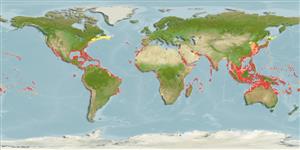Classification / Names
Common names from other countries
Main reference
Size / Weight / Age
Max length : 70.0 cm TL male/unsexed; (Ref. 48635)
Environment
Marine; reef-associated; depth range 0 - 170 m (Ref. 9283), usually 2 - 10 m (Ref. 40849)
Climate / Range
Subtropical, preferred 27°C (Ref. 107945); 47°N - 24°S, 180°W - 180°E
Distribution
Circumtropical. Indo-Pacific: East Africa (Ref. 3287) to Rapa, north to southern Japan and the Hawaiian Islands, south to New Caledonia. Eastern Pacific: Mexico to Peru, including the Galapagos Islands (Ref. 5530). Western Atlantic: Nova Scotia, Canada and Bermuda through the Gulf of Mexico and the Caribbean to to São Paulo (Ref. 47377), Brazil. Eastern Atlantic: Cape Verde to southern Angola (Ref. 7097).
Countries | FAO areas | Ecosystems | Occurrences | Introductions
Short description
IUCN Red List Status (Ref. 115185)
Threat to humans
Reports of ciguatera poisoning (Ref. 30911)
Human uses
Fisheries: highly commercial; gamefish: yes; bait: usually
Tools
Special reports
Download XML
Internet sources
Estimates of some properties based on models
Phylogenetic diversity index
PD50 = 0.7500 many relatives (e.g. carps) 0.5 - 2.0 few relatives (e.g. lungfishes)
Trophic Level
3.8 ±0.2 se; Based on diet studies.
Resilience
High, minimum population doubling time less than 15 months (K=0.6-0.9)
Vulnerability
Moderate vulnerability (39 of 100)
Price category
